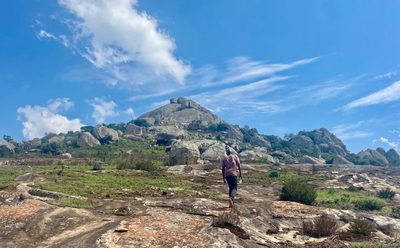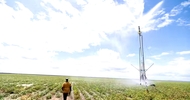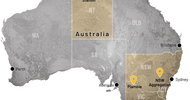The World Bank’s land conference returned this year in May after a gap since 2019. It is the go-to venue for mainstream (economic) debate about land. To a room full of suits, the conference was opened by a keynote from Andrew Steer, now President and CEO of the Bezos Earth Fund (and formerly of the World Bank, DFID, WRI etc.). If Steer says so, ‘land governance’ has surely arrived back on the main stage, and now firmly linked to the ‘big’ issues of climate and biodiversity.
His speech was intriguing; as ever things to agree with, but basically for him land security was about ensuring the stability of carbon markets (now they’ve been sorted out by various science based and integrity initiatives – mmm, not sure about that…!) and securing land for biodiversity by providing tenure security for Indigenous peoples to protect forests under the 30×30 conservation deal (not sure about that either…!).
I was only online for some of the sessions, but the contrasts between the two land conferences I have attended recently could not be more stark (see write-ups of the very different global land grabbing event in Colombia). I was mostly interested in the research track in order to see what new ideas are emerging. Central to this was the launch of a new World Bank ‘flagship’ report (actually a 217 page book) by Klaus Deininger and Aparjita Goyal and called, Land Policies for Resilient and Equitable Growth in Africa.
As the associated blog summarises, increases benefits from land assets can be crucial for Africa’s development. No dispute there. But some questions did emerge when I read the report. Here, I focused on the summary sections (which are long) and chapter 1 (on land institutions) and chapter 3 (on structural transformation). The two other chapters on urban land and climate change I skipped for now.
Yes, it was long… and I found quite repetitive, but with lots of useful data and references – many from the collected works of Deininger who has been a lead economist in the Bank’s research department for many, many years and kept the land flag flying, often with interesting ideas and challenging perspectives.
The World Bank land narrative?
So, what is the narrative of the report? At its core, the argument seems to run as follows:
- Land is important. Land and property account for 40 to 60 percent of household assets virtually everywhere,
- Land security (even if ‘short of’ title) is essential for investment (and collateralized credit etc.) and for taking on riskier, higher return activities
- This results in ‘structural transformation’ in rural economies over the long term (including out-migration, land consolidation, farm commercialisation).
- Despite their prominence in policy debates, formal land titles are very limited (perhaps 1% of land in rural Africa and 25% in urban areas). And they’re expensive to issue and administer (hundreds if not thousands of dollars to establish and exchange). Too often the titles issued excluded women.
- However, digital technology can solve this. As is shown in the iconic cases of Rwanda and Ethiopia. This is easy, fast, cheap, and titling (or registering land use rights) can be outsourced to the private sector.
- Such a move will help reduce market frictions, increase competitiveness in land markets, and can be digitally linked to other services including markets for insurance, credit and so on. Having land registration can in turn allow for taxation and provision of focused agricultural services, inputs supplies and so on.
- With efficient land markets, this will all lead to long-term rural change for the better, as well as increasing women’s empowerment (through individual registration) and addressing climate change (particularly through the role of public land and allowing carbon markets to function).
All this will be wonderful if, of course, it’s all done properly and that the registries continue to work efficiently and effectively after the big-bang titling programme. And pesky politics doesn’t intervene (reducing land security to allow appropriation, manipulating land registration systems etc.), whether under land redistribution programmes or large-scale investment initiatives. All were constraints identified in the report.
It all has a logic, but there are so many assumptions, articles of faith, ideological commitments and leaps of logic embedded in the argument. That questions of political economy only come in as qualifications is of course bizarre, but par for the course for much standard economic analysis.
I haven’t engaged with Bank material on land for a while, so this was a good education, but some of it was so wedded to a particular economic narrative that it ends up with some quite bizarre statements – for example, if rights are not clear, then land must be defended in other ways, so women stay at home (which is inefficient) and people plant trees on boundaries as markers (p. 24)!
Land security: to title or not?
I don’t think anyone disputes the importance of land holding security, and that this has many benefits for production, markets and so on, but how to do this remains the big question. This has of course been a debate within the Bank for a long time, with land researchers often pushing back at a privatisation (aka titling) at all costs stance. I detected a tension in this report, which recognises that the titling doesn’t make economic sense in most of rural Africa, but registration of land, especially if made cheap through digital systems, does. Yet the language of ‘short of title’ is revealing, and it is clear what the ideal is.
The cases of Mexico and Zambia are instructive. In Zambia in a study of large farms, Ali and Deininger found that “land titles have only limited impact on investment, reduce participation in land rental markets, and have no effect on credit access or productivity” (p. 164). Based on the Zambia experience, the report concludes that “formal titles will not automatically lead to credit access, investment, or job creation. Instead, titles that cannot be maintained locally may be associated with speculative land acquisition that may reduce rather than improve the functioning of rural factor markets” (p.154). Other factors (yes political economy) are at play. The case of Mexico in turn shows that full titling is not the magic wand so often assumed: “Issuance of use rights rather than full titles may come with some restrictions on land transactions… [but] such restrictions did not preclude large economic impacts and contribution to structural change via longer-term leases and migration” (p.55).
The digital solution?
The report has lots of other interesting cases, some elaborated in quite some detail both in ‘spotlights’ and across the text. Given the strong focus on digitisation, not surprisingly Rwanda and Ethiopia feature heavily.
So, “Rwanda adopted regulations allowing the use of high-resolution satellite imagery (under a “general boundary” concept) to issue titles to 11 million parcels at a unit cost of less than US$6 over two to three years…. Rwanda is the only African country with a fully digital nationwide registry and cadaster.” (p.5).
Meanwhile in Ethiopia, “from 2003 to 2005, land-use certificates were issued to more than 18 million parcels by 6 million households at low cost [less than a dollar] in an equitable way led by elected councils….. A follow-up “second-round” certification created a computerized and fully georeferenced registry with more than 22 million records of public and private land that has been used in 350 woreda (county) offices to register more than 750,000 transactions of different types using digital workflows that incorporate regulatory differences across regions” (p.6).
These programmes are widely celebrated, with studies suggesting all sorts of benefits from reducing conflict, strengthening women’s rights, raising spending on food and health care, increasing tenure security and investment in land improvements, including boosts in soil fertility, along with heightened participation in informal rental markets. Benefits for climate change, environmental protection, state supervision and provision of agricultural extension advice and more are also touted.
Alongside more immediate material and social benefits, the implications for long-term ‘structural transformation’ are also highlighted. For example, the report argues that “Removing obstacles to rural factor market functioning, encouraging intergenerational transfers of use rights, and improving the scope for contracting with private parties higher up in the value chain can foster structural change in rural areas. Clarifying rights—including to public land—to foster investment, integration into larger markets, and insurance and publication of land price and climate risk information can strengthen resilience and encourage private adaptation efforts” (p. 12).
It all seems too good to be true. Well, it is. As the report notes, “The fact that formally documented land rights are a precondition to use of land as collateral for long-term credit and financial market development has long provided a justification for efforts to expand access to formal rights via ‘“titling,” often at subsidized rates in rural areas. Data suggest that, in most of Africa, such interventions failed to overcome high levels of informality, wealth and gender bias of formal registries, competition between customary and formal authorities, and weak public land management….”. (p.17).
Even when a flashy digital titling or land registration is paid for by a donor, maintaining the land registry (and avoiding all the problems that have been experienced in the past) is not easy. Land administration systems have to continue working for the long-term, with efficiency, transparency and lack of interference. A tough call when land is so political.
The failure of land deals, but why they are still a good idea!
The are some intriguing sections on the failure of ‘land deals’ (some for good reason call them ‘grabs’) to deliver the expected structural transformation in rural Africa (that the Bank of course promoted). This again is put down to ‘inefficient markets’ and ‘failures of governance’.
The report observes, “large farm establishment failed to create jobs and had little effect on smallholders’ access to technology or input and insurance markets while often competing for land. One reason was the use of centralized and noncompetitive mechanisms to transfer land that, together with formal land institutions’ limited local presence, made it difficult to identify capable investors, enforce environmental and social safeguards, collect ground rent or other lease payments, and liquidate unsuccessful ventures, encouraging speculative land acquisition” (p.15; also 152).
Well, what a surprise! And still, despite this dismal experience, the report promotes large-scale land investments, singing the praises of oil palm in Indonesia and similar ‘high value’ investments in Latin America (p. 151). I think a few from these regions will have other things to say!
Structural transformation, of what to what?
The sections on ‘structural transformation’ were interesting but left me a little confused. The core argument seemed to be that formal registration, ideally titling, would allow for efficient land markets, land consolidation, out-migration and the growth of off-farm economies. This would then be the conditions under which ‘land deals’ would work, allowing investment into ‘underused’ African land through efficient, well-managed land markets, with land security improved through (digital) registration.
The position was summed up in the opening paragraph of chapter 3, “Secure land rights will increase not only owners’ investment incentives but also allocative efficiency by making it easier to transfer land to those best able to make use of it in ways that benefit everybody. Because farmers have to deal with high levels of risk and multiple factor market imperfections, efforts to improve clarity and transferability of land rights will be most effective in increasing productivity if they help to improve the functioning of other factor markets and farmers’ ability to insure against risk as well. Comprehensive digital and georeferenced documentation of use rights in a way that can be integrated with farmer registries and accessed (with farmers’ permission) by banks, traders, input suppliers, or providers of crop insurance may reduce frictions in land as well as other factor markets and contribute more to this objective than isolated issuance of titles” (p. 135).
Following this argument, the report argues, based on experience in China/Taiwan, that “longer-term rentals that can support structural transformation and a gradual shift of employment from agriculture to non-agriculture usually require more formal documentation. Historically, reforms to replace oral short-term rental contracts with written ones for a longer term, together with a public body for enforcement, fostered tenants’ investment in irrigation and drainage, leading to significant efficiency gains” (p. 24).
Yet, on the same page, this time based on Mexican experience, “Documentation of land rights at the community level…. facilitated long-term land rentals, occupational shifts to non-agriculture, and migration”. This was far short of titling and focused on supporting communities to demarcate and register land. The idea that nothing will happen in the long-term unless there is formal land use rights registration was disputed. This is of course the experience of Zimbabwe, where the lack of formal documentation around land has not prevented very substantial investment, with many spin-off benefits both for land holders and the wider economy, even if there will be benefits from further formalisation under an effective land administration. Formalisation has benefits (and costs and risks), but it is clearly not the magic solution and does not ’cause’ transformation – that’s far, far more complex. It was all a bit confused and confusing.
Clearly there are a number of subtexts within the Bank’s position, which are not wholly supported by (all of) the data. First that large-scale deals (in the end) are a good thing, and second that formal land registration is essential and can open up opportunities for them but for this to be part of a ‘structural transformation’. Land markets thus must operate to get people off the land to other forms of gainful employment. The old argument for the value of small-scale farming (based on the ‘inverse relationship’) seems to have been surpassed with arguments that large-scale is best, if the markets (and institutions) work well.
Well, there are quite a few assumptions here and, once again, questions of causality arise.
What to conclude? The need for a contextual, grounded approach
Clearly in some places at sometimes processes of formal land registration of use rights have given rise to certain gains, but in other places and at other times, they have not. Land deals and large-scale farms may have benefits in some circumstances, but in other cases they are clearly ‘grabs’, undermining livelihoods and local economies. Land reform and redistribution is vital to address inequalities and can boost economic activity, but only under certain conditions.
Confidently proclaiming on the basis of some cases not others that there is one way forward (here centred on digital land registration it seems) is to my mind very problematic. It all depends, and in the end it’s contextual factors – yes political economy again – that matters.
The Bank (and economists more generally) too often like big-sweep recommendations based on simplified models of market behaviour and the assumed actions of economic actors, but in practice it’s always more complex, uncertain and contingent. When particular cases don’t fit or facts get in the way, they can be brushed aside or misinterpreted. The two references to our work in this report are cases in point. One claimed that we made the case that large-scale land deals improved opportunities for knowledge transfer to local farmers and the other that Zimbabwe’s land reform generated “minimal economic benefits” and for the beneficiaries, “few options for economic advancement” (p. 162-3). Neither of these sound remotely like our work, but the way data and evidence are used in a report driven by particular (political) commitments, is always interesting.
So, what to do? Despite its limitations, gaps and uneasy logic, the report is important – and especially so given its provenance. The big investment opportunity (aka focus for future Bank loans) looks like African land registries and digital tech (linked across functions). Other donors I am sure will love this, always eager for a seemingly quick tech-fix to complex problems.
But, as the report itself admits, it’s not straightforward. By all means make use of new technologies to make things easier, but don’t expect them to provide the magic bullet. For land governance more generally, we can agree on the need for land security, but how to get to this end has to be worked out on the ground, engaging with local contexts and political economies. And this is always much more difficult than the neat economic models assume.
This blog was written by Ian Scoones and first appeared on Zimbabweland













